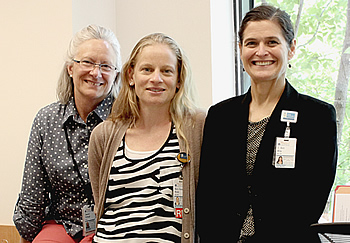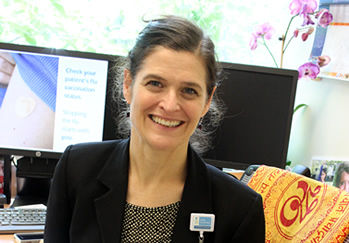While our culture in general seems to show a high interest in integrative healthcare and alternative medicines — witness the popularity of juice cleanses, yoga studios popping up everywhere — most hospitals and healthcare establishments remain strictly traditional in how they approach treating patients.

Mary Wade, RN, and her colleagues at the UVA Primary and Specialty Care Pantops find this entrenchment frustrating.
“Ever since I went to nursing school and went to my first job, I was really mad at the doctors, thinking, how can you not tell your patients about their diet, educate them about their food, their medications?” Wade says. “Some people don’t even know what insulin is, and they’re taking it every day. They don’t know what sugar does to their body.”
The factors at play:
- Lack of time
- Lack of training
- Lack of awareness about the benefits of a different approach
Integrative Healthcare: Traditional & Holistic
The three main goals for the one-year-old integrative medicine clinic:
- To improve patient care by providing highly attentive care
- To establish a multidisciplinary clinic that incorporates family and internal medicine, including prenatal and newborn care
- To integrate therapies and medical modalities to help patients restore balance and mind-body connections
Way talks about how all these goals benefit the patient experience. “Yesterday I had a patient with some neck/vertigo issues and upper back spasms; she was interested in seeing the acupuncturist, so she saw him after seeing me. Where else are you going to get that? It’s really cool that it can be all under one roof.”
The clinic offers home visits, too. Integrative healthcare means integrating the patient, too. Cawood Fitzhugh, NP, adds, “We listen to you, partner with you, we integrate you into decision making about your health.”
Integrative Medicine
This clinic offers:
- Acupuncture
- Medical yoga therapy
- Mindfulness-Based Stress Reduction
- Massage Therapy
- Nutrition counseling
Prevention: It Takes Time
What’s new about this new integrative medicine clinic represents an even bigger shift than just new methods of treatment. “Instead of only treating disease, we’re trying to go a step before that and prevent people getting the disease,” Fitzhugh says.
This model challenges the current ways of managing care. Fitzhugh continues: “It doesn’t fall into the current medical model or business model. Creating balance in someone’s life and helping them boost their immune system, discuss what effect exercise has on them — you can’t do that in 15 minutes,” referring to the standard time allotted for a primary care office visit.
The three explain that shifting from treatment to prevention requires more time than everyone involved is used to, not to mention using new ways of measuring success.
Denise Annie Way, MD, explains: “In traditional medicine, we look at short outcomes in our patients — did their blood pressure come down, do they have fewer migraines — looking at the three-month point. With complementary therapies, it takes a longer time before you see a difference; long-term outcomes are just more difficult to assess.”
The cost savings of avoiding illness, however, point to clear benefits. “We’d be saving people millions of dollars by not getting them in the diabetic zone in the first place,” Way explains.
The Growing Shift Towards Holistic Care
The other challenge in introducing integrative therapies? Medical codes don’t exist for many of the offerings the clinic wants to provide.
However, providers can bill for services like mindfulness training when they are woven into the fabric of care.
Way gives an example. “We incorporate mindfulness and yoga a lot when we’re treating patients, for decreasing anxiety, pain and depression. It’s invaluable.”
Emphasizing Wellness & Happiness
Will holistic healing become more mainstream? Way has hope. “A lot of this is going along with what’s happening culturally,” she adds. “The complementary therapies are getting more and more recognition.”
By moving into this domain, she feels, UVA shows a willingness to join and even lead the cultural shift towards preventive healthcare.
“Our culture doesn’t put emphasis on wellness,” Wade says. “But doctors are getting more pressure to keep patients healthier, and that’s where the concept of this clinic came from.”
Way sees this gradual turn towards integrative healthcare as part of a larger fundamental society paradigm shift. “It’s not just about making the patient get better numerically, but do they feel good and have a high quality of life? How do we view happiness? To be happy may be more important than control of your health problems.”
Nutrition & the Whole Family
Integrative healthcare includes diet considerations. Nutrition services play a key role in addressing everything from obesity to stress. The registered dietitian at the clinic helps integrate eating practices into the overall health and wellness goals at the center of patient care. “The RD even trains patients in Emotional Brain Training, to help patients who need to lose weight avoid stress eating.”
The advantages of the family medicine model? Wade has found that addressing the way the whole family eats is crucial. “You eat together as a family, so changing one person’s eating habits, you have to look at everybody’s,” she says.
Wade tends to focus on the women in the household. “Women are mainly the hunters and gatherers these days, so we choose what we bring into the house. If women are educated on their food choices, they impact the whole family in a positive way.”
A Gentle Approach to Diet Changes
When working with patients, Wade emphasizes a gentle approach to change, especially for people with food and eating issues. “You can’t say ‘always’ and ‘never’ for food. You have to work with what you have. It’s always possible to make better choices, just a little bit, and those will help you keep going.”
She often has people commit to a change for a couple of weeks, as an experiment. For example, she’ll ask patients to try brown rice instead of white or avoid colas. “It’s not for the rest of your life,” Wade tells patients. “You’re just going to try, just take baby steps.” The result? “Most of the time they want more, want to know why they felt different.”

Yoga Therapy
“Most people relate yoga to a vinyasa class in fancy clothes with wild music doing a lot of postures,” Way says. “Medical yoga is pretty far from that. It’s the application of yoga to medical problems with a personal approach.”
If and how yoga therapy can be applied depends on your illness. Way also performs an in-depth assessment to evaluate a patient’s condition and various needs.
Integrative healthcare is holistic. She gives an example. “Maybe they have back pain, anxiety and diabetes,” she says. “The yoga therapy prescription would involve yoga postures for glucose control, meditative breathing for anxiety and stretching and strengthening for the back.” This research-backed, individualized approach would streamline the treatment for all three issues.
“Studies are showing that patients continue to do yoga therapy on their own for three years,” which means, Way explains, that “you’re not only fixing them in the clinic, but creating patient autonomy and overall patient wellness for life.”
This pattern contrasts with typical physical therapies where, for instance, a patient performs back exercises for the proscribed amount of time and then stops, only to have recurring pain a year or so later—and a return to the doctor.
Interested in Integrative Medicine?
Make an appointment to visit the clinic.
“This is what integrative healthcare is about, what mindfulness is about: changing how you feel overall, not dependence on the health system, not dependence on me. It’s when you’re depressed in the middle of January, and you roll out your mat and do yoga and it’s free.”
Way adds, “You don’t have to do yoga 90 minutes a day or buy $90 yoga pants. It’s fine to sit still for five minutes and meditate, that’s yoga; you get benefits from that.”
Wade nods. “We’re giving people the tools to take a role in their own health.”

Greetings,
I wonder if it is possible for me to change my “Primary Care Provider” as listed for Medicare purposes from a local clinic here in Lynchburg to the UVA Integrative Medicine Clinic. I’m perfectly willing to travel the distance to receive a higher standard of care, but I don’t have anyone with whom I can discuss a few pros and cons of doing so. Please help?!
Thank you, Ayanna, for reaching out. Try calling Dr. Way or really any of the providers at the clinic at 434.297.7140. They can certainly talk with you about the services offered and help you make that decision! Good luck.
Can you Tell us if you have Ayurvedic Medicine as an option to traditional medicine?
Example: Chopra Center in San Diego, where they practice Ayurvedic Medicine as a form of healing.